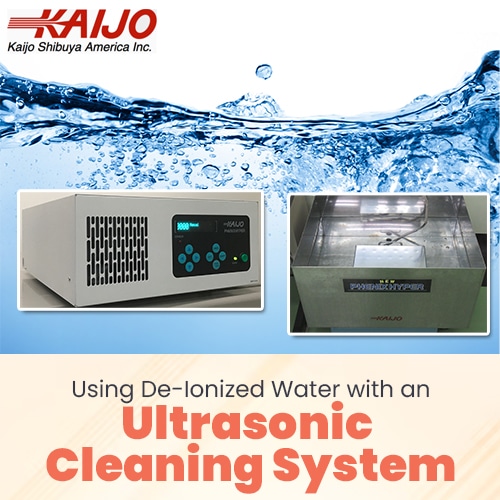Using De-Ionized Water with an Ultrasonic Cleaning System
September 7, 2023
 Editor’s Note: This article was originally published in October 2017 and has been updated with new information and reposted in September 2023.
Editor’s Note: This article was originally published in October 2017 and has been updated with new information and reposted in September 2023.
Ultrasonic cleaning is a powerful and versatile method that removes contaminants from various materials. It’s often used in automotive, electronics, medical, and manufacturing industries. Cleaning fluid plays an essential part in this process, and using deionized water can significantly enhance the performance of an ultrasonic cleaning system.
De-ionized (DI) water is one of the preferred choices for many ultrasonic cleaning applications. What makes DI water stand out, and when should you use it? In this article, we’ll explore how de-ionized water affects ultrasonic cleaning applications when it is appropriate to use, and how it can improve the cleaning of certain parts and devices.
What is De-Ionized Water?
De-ionized water (DI) is plain water that has been purified to remove ion contaminants. Typically, these ions include minerals like calcium and magnesium, which are commonly found in tap water. The de-ionization process removes these ions, providing much purer water than regular tap water. The removal of ions from water provides some significant implications for ultrasonic cleaning.
Benefits of De-Ionized Water for Ultrasonic Cleaning
Enhance Cleaning Performance:
Using Di-ionized water (DI water) can improve the cleaning performance of ultrasonic cleaning systems. This is especially crucial when cleaning delicate parts that can’t tolerate the use of detergents. In specific applications, using an ultrasonic cleaning tank with a heater that heats the DI water can also make ultrasonic cleaning more effective than plain water. The lack of ions in DI water means it can absorb contaminants more readily, making the cleaning process more effective overall.
Improved Rinsing:
Once ultrasonic cleaning has taken place, parts must be rinsed to remove any remaining cleaning solution. Due to evaporated minerals and other impurities, regular water can leave spots or films on parts. Rinsing with DI water that contains no impurities ensures clean, spot-free parts.
Detergent Efficiency:
When a mild detergent is used in plain water with ultrasonic cleaning, the detergent absorbs any impurities present before removing the contamination. With DI water, there are no impurities to reduce the effectiveness of the detergent. The cleaning power of detergent can be maximized to remove contaminants effectively from the surface of parts.
When to Use DI Water
DI water is recommended for cleaning delicate parts such as semiconductor wafers, printed circuit boards, and medical devices that could be damaged by detergents. DI water helps ultrasonic bubbles clean more rapidly without resorting to detergents as a cleaning agent.
DI water is ineffective in speeding up cleaning parts that contain stubborn grease and oil contamination. Instead, a mild detergent or solvent explicitly designed to tackle those contaminants is needed. Typically, a solvent that helps dissolve the contaminant but does not damage the part being cleaned can be found. In contrast, using DI water throughout the cleaning process is beneficial for other forms of cleaning.
DI water may not be effective at removing stubborn grease and oil contamination. In these cases, using a mild detergent or solvent that specifically dissolves the contaminants may be more suitable. In such circumstances, using DI water for post-cleaning rinse remains beneficial.
Kaijo’s Expertise in Ultrasonic Cleaning Systems
With over 65 years of experience in ultrasonic cleaning technology, Kaijo offers expert consultation and advice on using ultrasonic cleaning systems. Our team can assist in determining whether DI water would best fit your application. With an extensive range of ultrasonic cleaners and components, we can provide tailored recommendations to meet each customer’s requirements.
Kaijo can offer expert guidance in selecting appropriate ultrasonic frequencies for your cleaning applications and assistance in configuring your system.
Using de-ionized water in ultrasonic cleaning systems can enhance the cleaning process, especially for delicate parts. Ultrasonic cleaning efficiency can be significantly improved when used with the right detergents or solvents. Contact us for a complimentary consultation about using ultrasonic systems in your application.





